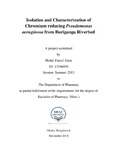| dc.contributor.advisor | Kabir, Eva Rahman | |
| dc.contributor.author | Alam, Mohd. Faizul | |
| dc.date.accessioned | 2018-11-28T04:47:52Z | |
| dc.date.available | 2018-11-28T04:47:52Z | |
| dc.date.copyright | 2018 | |
| dc.date.issued | 2018-11 | |
| dc.identifier.other | ID 13346050 | |
| dc.identifier.uri | http://hdl.handle.net/10361/10881 | |
| dc.description | This project report is submitted in partial fulfilment of the requirements for the degree of Bachelor of Pharmacy, 2018. | en_US |
| dc.description | Catalogued from PDF version of project report. | |
| dc.description | Includes bibliographical references (page 55-62). | |
| dc.description.abstract | The hexavalent form of Chromium is known to possess carcinogenic and mutagenic property and causes various serious diseases such as skin cancer, lung cancer, pulmonary congestion, etc. Salts containing hexavalent form of Chromium are an important component in various sectors including leather, tannery, dye, stainless steel etc.; and are being discharged into the natural environment every day without any treatment, thus making it very hazardous for human health. The following study aimed to discover the ability of bacterial strain C2 to reduce hexavalent Chromium to its less toxic trivalent form. Water and soil samples were collected from the Buriganga River. Bioremediation assay was carried out on samples of the bacterial isolate containing K2CrO4 (Potassium Chromate) at combination of temperatures- 25⁰C, 37⁰C and 42⁰C and pH 5.5, 7 and 8.5. Therefore, a total of 9 samples were prepared and monitored for their Chromium reducing ability, by checking for their absorbance using a UV spectrometer. It was observed that, the bacterial isolate was able to reduce Chromium completely at 37⁰C and 42⁰C, both at pH 7. The isolate failed to show any significant reduction at all pH values in 25⁰C. Furthermore, Antibacterial Susceptibility Assay and Minimum Inhibitory Concentration (MIC) tests were performed. The isolate showed greatest susceptibility to Ceftriaxone (201.7± 1.89 ZI/mm), Neomycin (19± 1.00 ZI/mm), Gentamycin (18.67± 0.5867 ZI/mm) and Ciprofloxacin (18.5± 0.867 ZI/mm) and least susceptibility to Vancomycin (8.33± 0.57 ZI/mm) and Penicillin (0 ZI/mm); and showed moderate susceptibility to other test antibiotics. In addition, the MIC of K2CrO4 at 16mM. No significant correlation was observed between the reduction capacity, MIC and Antibiotic Resistance property of the isolate. Finally, 16s rRNA sequencing was conducted to identify the unknown isolate, in accordance with the utilization of nucleotide BLAST, Finch TV, BioEdit and Mega 7 tools to identify and trace the origin of bacterial isolate C2. Consequently, the identity of the isolate was confirmed to be Pseudomonas aeruginosa. | en_US |
| dc.description.statementofresponsibility | Mohd. Faizul Alam | |
| dc.format.extent | 64 pages | |
| dc.language.iso | en | en_US |
| dc.publisher | BRAC University | en_US |
| dc.rights | BRAC University project reports are protected by copyright. They may be viewed from this source for any purpose, but reproduction or distribution in any format is prohibited without written permission. | |
| dc.subject | Chromium | en_US |
| dc.subject | Pseudomonas aeruginosa | en_US |
| dc.subject | Buriganga | en_US |
| dc.subject.lcsh | Pseudomonas aeruginosa infections. | |
| dc.title | Isolation and characterization of chromium reducing pseudomonas aeruginosa from Buriganga riverbed | en_US |
| dc.type | Project report | en_US |
| dc.contributor.department | Department of Pharmacy, BRAC University | |
| dc.description.degree | B. Pharmacy | |

